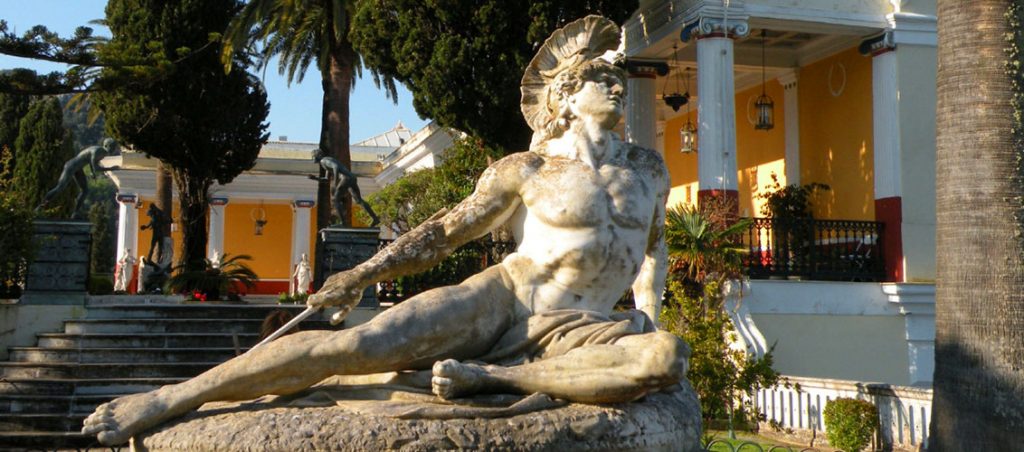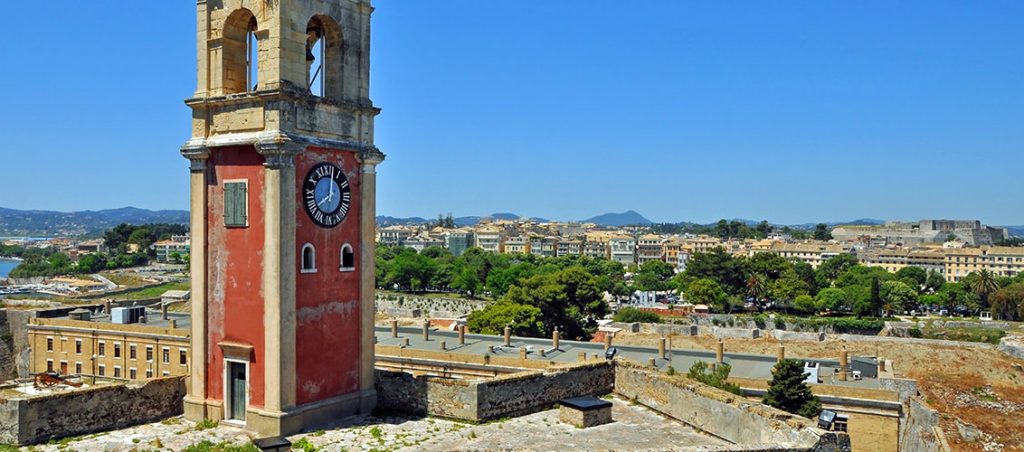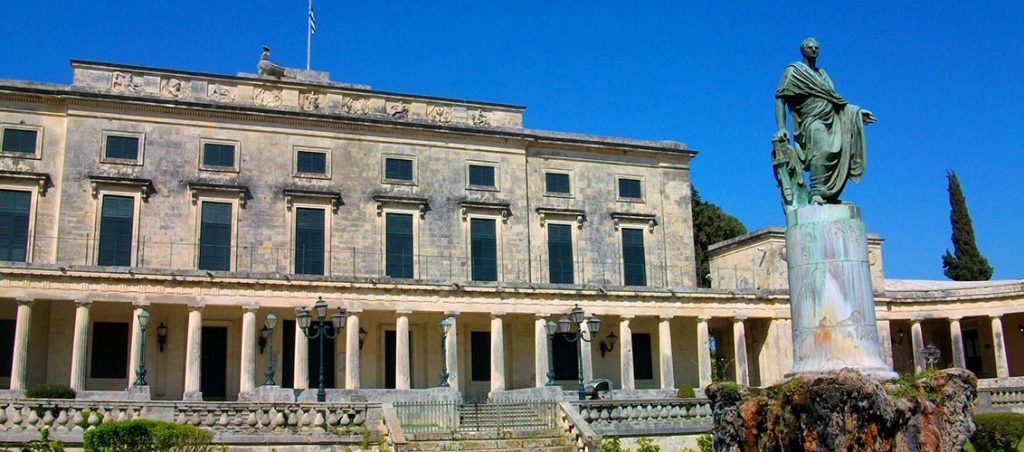ANCIENT TIMES & MEDIEVAL AGES
In the area south of the modern city, which nowadays is settled the Kanoni peninsula, was the ancient city of Corfu. The name of the ancient city was Chersepolis and Corinthians were installed there by Chersicrates in 734 BC.The Island was under the rule of the Corinthians till 435 BC and soon it became a vigorous power and an economic force with a strong navy.
During the Peloponnesian War (431 BC – 404 BC) Corfu allied with Athens and that led to the diminishment of Corfu’s power. From 229 BC to 337 AD Corfiots, numerous attacks from the pirates from all over the Mediterranean, as well as the wars with the Illyrians, asked for the Roman protection. During the first century AD, Christianity was brought to the island by the two disciples Jason and Sosipatros.
In 337 AD, the Roman Empire collapsed and Corfu became a part of the Eastern Roman Empire a lot from the barbarian raids of the Arabs, Huns, Vandals and Goths. In 1147, the island was under the rule of the Norman king Rogiro before eventually it was set free by the Byzantine Emperor Emmanuel I Komninos.

CORFU HISTORICAL RULES
THE RULE OF ANJOU
Corfu was offered as a dowry to various kingdoms. In 1204, after the crusaders from the 4th Crusade conquered the Byzantine Empire, the Venetians acquired Corfu under their rule. But, in 1214, Michail I Aggelos Komninos recaptured the island and it became a part of the Despotate of Epirus.
Under the rule of Michail I Aggelos Komninos, the island’s fortifications were strengthened and its inhabitants’ privileges were restored. In 1267, due to the Battle of Beneventum and the Treaty of Viterbo, Corfu has been under the rule of the French king Charles I of Sicily, also known as Charles of Anjou, for 120 years.
Charles of Anjou was against the Orthodox religion and demanded the replacement of the Orthodox churches with Catholic. Thanks to the rise of various Corfiot political groups, the island was recaptured from the Venetians in 1386 and was under their protection.
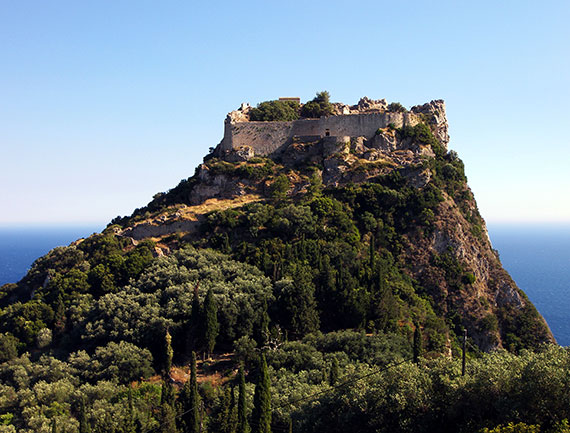
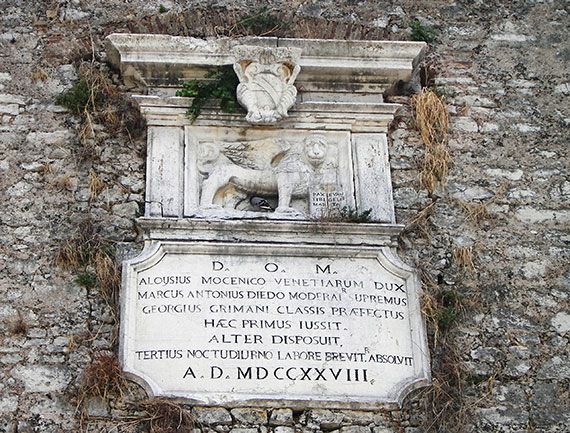
THE VENETIAN RULE
Approximately four centuries under the Venetian rule determined the character of the island. The existing feudal system was corrected through the nobility, which was listed in the Libro d’Oro. While the rest of Greece was under Turkish rule, Corfu had a rich cultural life and many literary and artistic figures came to Corfu from other parts of Greece.
Education of the working class was undertaken by the priests in the monasteries while the wealthier classes had the opportunity to study in the universities of Italy. Venetians showed a special interest in agriculture and more particularly in the cultivation of olive trees. Corfu’s cuisine was highly influenced by the Venetian Cuisine and this is where the famous traditional delicacies like Pastitsada and Sofrito come from.
Corfu was fortunate to be under the Venetian rule since that allowed the island to expand its cultural horizons and Corfiots had the opportunity tο publicize in Europe the classical meaning of the ancient Greeks through their work. It is said that Corfu owes a lot to the Venetians; because of them, the island was never conquered by the Ottomans.
THE RUSSIAN – FRENCH RULE
After Venetians were defeated by Napoleon Bonaparte the treaty of Campoformio was signed which decreed the French hegemony all over the Ionian Islands. One of the first things French invaders did, was to burn in the main public square of Corfu the Book of Gold, the list of the nobles of the island, and in the same public square they planted the symbolic tree of the freedom.
The Corfiots felt a wind of rebirth and they accepted willingly the new ideals that were promoted from the French revolution, hoping also that Napoleon could help Greece to get back the freedom. Anyhow, the French hegemony was not really accepted by Russians and Turks, so in 1799 the island came under the control of the Russian Admiral Fyodor Ushakov therefore in order to limit French power, they instituted in 1800 a treaty that for the first time recognized the United States of the Ionian Islands as a free and independent state.
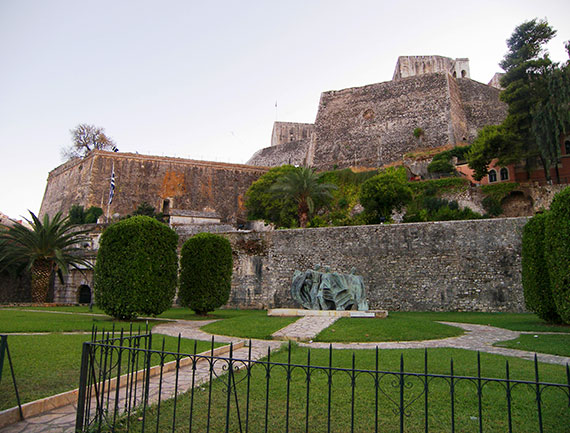
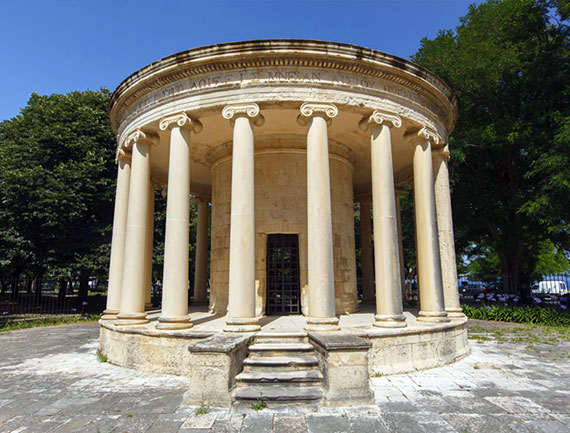
THE SECOND FRENCH RULE
The State of the Ionian Islands passed through a flourishing period and Corfu was “reborn” in many levels. But, in 1807 the French re-established their dominance. With the Treaty of Tilsit in 1807, Corfu was ceded to Napoleon again. The French improved the stylistic appearance of the city by planting trees on Spianada Square (Venetian defensive place) and the Liston Promenade, in the style of the Rue de Rivoli in Paris.
They introduced the cultivation of potatoes and the vaccination of citizens. For several years Corfiots and French people lived together and in that period Corfu increased its economy and the public education was flourished; during that period the first Ionic Academy of Sciences was instituted and the first Greek printing office was introduced.
THE BRITISH RULE
In 1814, Corfu was assigned to the British, after Napoleon’s defeat. The British guardianship had many beneficial effects on both the economy and the education. In 1824, the Ionian Academy was established by the British politician and colonial administrator Sir Frederick North, 5th Earl of Guilford.
Public works like a new water supply system and a functional road system were created, building an aqueduct, restructuring the Old Citadel and adding new military buildings at the expense of the Venetian buildings, reconstruction and raising of the town’s dwellings. Also, the British brought Cricket to Corfu and it soon became a very famous sport on the island. Most importantly, during the British Occupation, the Greek language became the official language of Corfu for the first time.
The Ionian Bank was a British overseas bank which investors established in 1839 to operate in the Ionian Islands and it also served as the central bank of the United States of the Ionian Islands. The bank later expanded in Greece and the Eastern Mediterranean. In reality the Ionian Bank was the first Greek Bank.
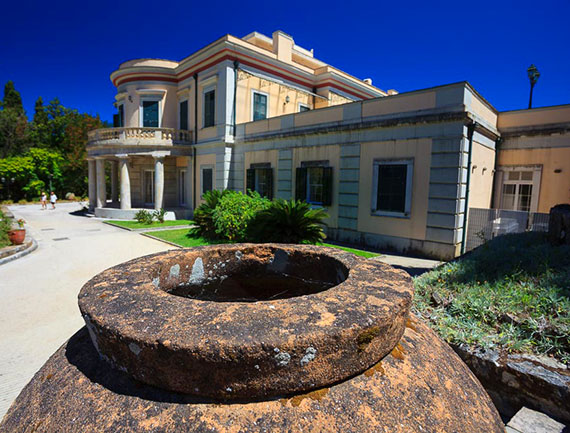
THE TREATY OF LONDON – WWI-WWII – MODERN DAY CORFU
In 1864, the Treaty of London was signed and the British ceded the United States of the Ionian Islands to Greece. Furthermore, they also appointed King George II to rule the newborn country. In Modern Greek history, Corfiot politicians also played an important role in Greek politics, like Georgios Theotokis, who was elected Prime Minister of Greece four times.
The Corfiot soldiers participated with distinction in the Balkan Wars, WWI and WWII. During the WWI Corfu was occupied by the alliance of ENTANTE with the military order to shelter the defeated Serbian army. 151,828 Serbian soldiers and civilians were evacuated with Allied ships from the Albanian port of Avlonas (Valona) to Corfu. The suffering of the soldiers and civilians finally stopped upon their arrival on the “Island of Salvation” as the Serbs named Corfu. During the Second World War the Italians took the power of the island until Mussolini died.
The invasion and control of Corfu and the Ionian Islands was part of Mussolini’s strategy to resurrect the Roman Empire, as Corfu has been an important outpost in the Adriatic. The Old Town was badly damaged by bombing in 1943.
Added to the loss of life was the destruction of many houses and public buildings (the Ionian Parliament, the theatre, and the library), fourteen churches, and a number of buildings in the Old Citadel. Corfu was eventually liberated by the British troops in October 14th, 1944.
After World War II and the Greek Civil War, the island was rebuilt under the general program of reconstruction of the Greek Government and many elements of its classical architecture remain. In 1984, the Ionian University was reestablished by the Greek Government and the Prime Minister Andrea Papandreou, after many efforts and disappointments of the Corfiots.
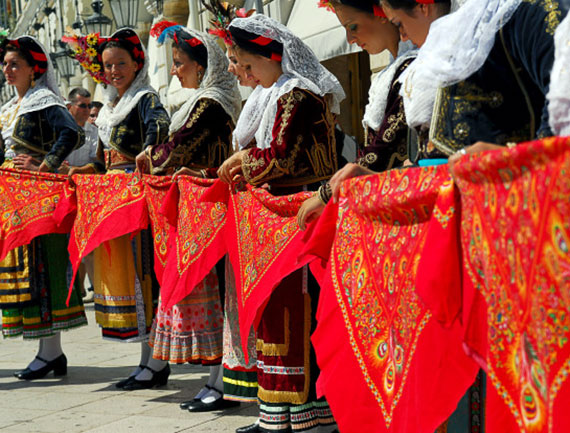
CORFU CULTURE AND RELIGION
After reading Corfu’s history, one can understand and admire the island’s impressive and flourishing culture. Due to the absence of the Ottoman domination, the island was mainly influenced by the Byzantine, Venetian, British and the other European states civilizations and adopted many of their traditions, without losing entirely its unique Greek identity.
Corfu began to develop an artistic tradition in the early of 16th century. Many great and important personalities were born in Corfu during the middle ages and renaissance. Mentioned by the Greeks as a part of the Modern Greek culture and bringing famous people who resided in Corfu as Lord Guildford, John Singer Sargent , Gerald and Lawrence Durrell, Edward Lear, Lord Rothschild, Elizabeth (Sissy) Empress of Austria and Kaiser Wilhelm II, Prince Philip of Greece and Denmark and so many other personalities of culture and art.
Concerning the religion, many attempts were made to change their religion but Corfiots defended their religion and remained -with few exceptions- Christian Orthodox. The leaders of the religion played a key-role in decision-making because believed it was their duty to remind everyone that Greece had to get liberated and anti-Christian Ottomans should be ousted. Corfiots never forgot their Greek roots and their religion.
THE ART OF CORFU
Corfu’s artistic tradition began to develop at the beginning of the 16th century. Around that time in the island of Crete the school of painting was established with the name “Cretan School”. Unfortunately, Crete soon came under the Ottoman domination and that led to many people coming as immigrants to Corfu, bringing with them to the island their work along with their artistic talent.
Today, in many churches around the island as well as in the Byzantine Museum, people can admire the artwork of the famous iconographer Michael Damaskinos, George Kotzias, the Corfiot hagiographer Emannouil Tzanfournaris, Angelos the Cretan and many others.
Father Emmanuel Tzanes, the famous Greek Renaissance painter, had also been living in Corfu from 1646 until 1655. His extraordinary piece of work can be found in the churches of Saints Jason and Sosipater, Panagia ton Xenon, Saint Nichola dei Vecchi, Saint George (in the Old Fortress) as well as in the Byzantine Museum and the monastery of Blessed Virgin Platitera.
Another famous painter from Crete, Theodore Poulakis, lived in the island of Corfu. His icons can be found in the churches of Blessed Virgin in Kassiopi and Saint Nicholas in Vyro, in the Byzantine Museum as well as in the Monastery of Blessed Virgin Platytera. Constantine Cantarinis and Father Stephen Tzangarolas are representatives of the icon painters who flourished at the end of the 17th century and the beginning of the 18th.
Some of their works can be found in the Byzantine Museum, in the church of St. Catherine, in the Greek Orthodox Cathedral and in the church of Panagia ton Xenon. Panayiotis Doxaras was a painter and the founder of the Septinsular School of Painting.
The school set religious iconography free from all ties with Byzantine tradition, leading Ionian religious paintings into the main stream of Western art. Doxaras and Damaskinos also introduced the technique of oil-painting in the Greek Iconography.
One of Doxaras most exceptional works is the decoration on the ceiling of Saint Spyridon’s church, which was painted in 1727. The first neoclassical sculptor of modern Greece was Paul Prosalentis and his contribution to the revitalization of fine arts in modern Greece was quite extensive. John Kalosgouros was a sculptor, an architect and a painter whose most famous works include the marble bust of Countess Helen Mocenigo and a portrait of Nikolaos Mantzaros.
Many painters from Corfu carried on the tradition from the 19th century to our own times. Dionysios Veyias is considered to be one of the first to practice the art of engraving in Greece.
The painter Charalambos Pachis founded in 1870 a private school of painting in Corfu and he is considered to be the most important landscape painters of the Septinsular School of Painting. The island of Corfu has been a source of inspiration for many artists. Edward Lear lived for some years in Corfu and his “Views in the Seven Ionian Islands” was published in 1863.
CORFU MUSIC
It is no secret that Corfiot people are very passionate about music. This passion derives from the influence of the Venetians, who introduced Opera to Corfu. In 1733, they opened the first theater with the name Nobile Teatro di San Giacomo di Corfù, where various opera performances took place. This attracted many Italian musicians, some of whom decided to live in Corfu permanently. The theater was converted into the island’s Town Hall in 1903 and remains there till today. A larger theater was built but was completely destroyed from the bombs during the World War II.
While Corfu was under the British Rule, the musical tradition was perpetuated by Nikolaos Chalikiopoulos Mantzaros, an Italian – Greek composer born in Corfu Island. He is famous for creating many musical compositions and establishing the first modern school of music in Greece.
Most importantly, he created the composition for Dionisios Solomos’ poem “Υμνος εις την Ελευθερίαν” (Hymn to Liberty), which ultimately became the National Anthem of Greece.
Another famous Corfiot composer is Spyros Samaras. He composed the Olympic Hymn, which was written the poet Kostis Palamas. The Olympic Hymn was performed in 1896, at the modern Olympic Games of Athens, after so many centuries of absence of the ancient Olympia stadium games.
Other memorable Corfiot composers worth mentioning are Spyridon Xyndas, who was a student of Nikolaos Mantzaros Chalikiopoulos, Napoleon and George Lambelet, Leonidas Albanas and Spyridon Kaisaris.
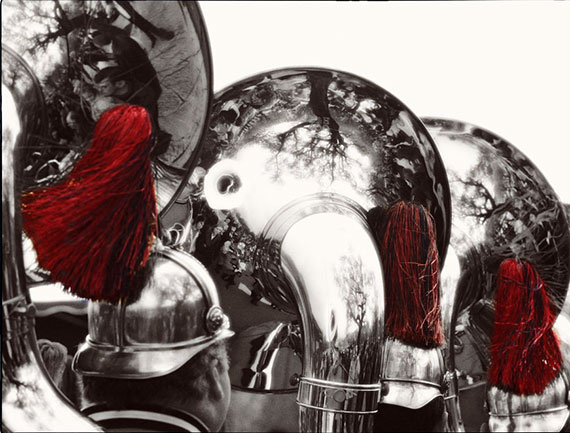
Corfu is particularly famous for its Philharmonic Orchestras that accompany parades and processions during the festivities of the island. Today, there are 18 philharmonic orchestras located in Corfu island. Some of them are located in Corfu Town and others in many villages. The most popular are the town’s Philharmonic Society of Corfu (palaia), the Philarmonic Society “Mantzaros” and the Philharmonic Union of Corfu “Kapodistrias”.
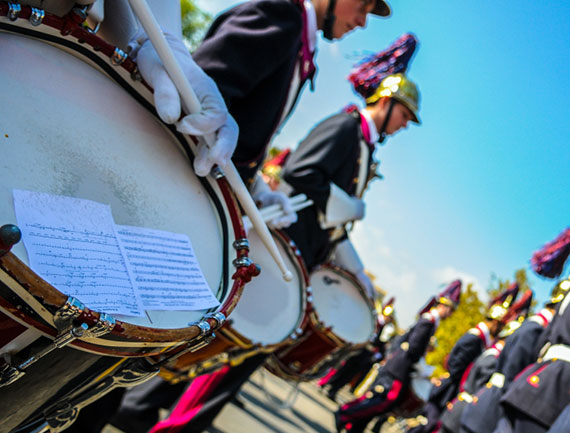
The Philharmonic Society of Corfu was established in 1840 and the band’s artistic director was Nikolaos Mantzaros Chalikiopoulos, who held this position until his death in 1872. Corfiots also call the Philharmonic Society of Corfu “Palaia”, which means old in Greek, since it is the oldest band in Corfu.
At the beginning the band was housed in Pinia (in the town) but in 1900 it moved to a new typical Corfiot “palazzo” also in Corfu town. The house belonged to the Theotokis family and this is where the Prime Minister of Greece, Georgios Theotokis, was born.
The Philharmonic Society “Mantzaros” was established in 1890 by a group of socialists and has contributed a lot in the cultivation and preservation of the musical tradition in Corfu. It is located in 23 Filarmonikis street, in the heart of Corfu town.
The Philharmonic Union of Corfu “Kapodistrias” was established in 1980 by a group of people who were previously members of the Philharmonic Society of Corfu.
Today, the band is cooperating with the department of Musical Studies of the Ionian University and it is located in 13 Agion Pateron Street in Corfu Town.




